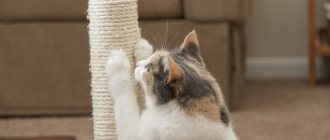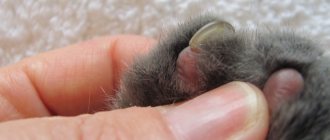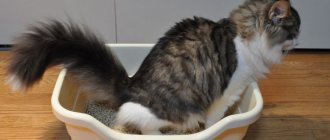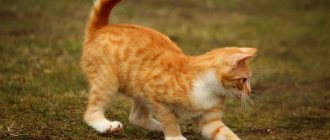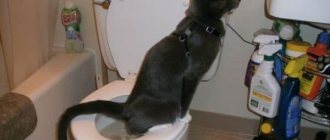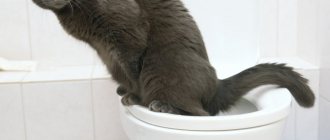If you have taken home a cat or a small kitten, you may be faced with the problem of sharpening its claws. Very often, owners do not expect that a small pet will begin to damage their favorite furniture and carpets. This leads to dissatisfaction and a desire to punish the cat. Animal psychologists argue that positive results can be achieved in other ways. In addition, many cats categorically do not accept the owner’s reproaches. If we talk about the character of the cat, it may seem that he behaves independently and with dignity.
How to train an adult cat to use a scratching post
First of all, you should remember that you cannot beat or scold a cat if it damages the furniture. To stop it, you need to use the command “No” in a stern voice, which can be secured by clapping your hands. This will make it clear to the animal that its intentions are perceived negatively.
You can also develop a consistent chain of actions for your cat. When he begins to sharpen his claws on the carpet, spray the animal with water. After a while, he will associate the water and the carpet with unpleasant memories and will begin to avoid such places. It’s good at such moments to call your pet to the scratching post and move its paws along the surface. Instinctively, the cat will extend its claws and grab onto the material. He needs to be praised and petted.
What measures should not be used when training a cat?
The main thing in training is to be affectionate towards your friend
In order for a cat to use the scratching post for its intended purpose, you must first of all be patient and not be too persistent in training. Don't demand instant results from your animal. Your pet needs time to get used to the accessory. Excessive pressure on the animal will only slow down the training.
You should not splash water on your cat while he is scratching things with his claws. The pet will be scared and afraid to do this trick again. The tailed animal will experience stress and may even become more aggressive, so this method can hardly be considered humane.
Don't yell at the animal. Do not grab the cat by the paws or tail or force it to scratch the product. She can link owners' aggression directly to the scratching post. Then the pet will be afraid of the claw hammer. In this case, it is necessary to start training again. The scratching post will have to be replaced with a new one, which is not associated with negative memories of the animal.
It is worth approaching responsibly when training a cat to use a scratching post. The pet friend does not understand human language and often scratches things without malicious intent. Therefore, you need to be affectionate towards your pet. In addition to accustoming the animal to the accessory, do not forget to constantly care for its claws and trim them in a timely manner.
Training a kitten to use a scratching post
Depending on the age of the baby, the accustoming process may proceed faster or, on the contrary, slower. But more often it takes 30 days or more.
At 1.5 months
To accustom a kitten to a scratching post at this age, you will need a little patience and his favorite treat:
- First, bring the treat to the scratching post.
- Call your pet.
- Raise the treat above the kitten's head so that it rests its paws on the scratching post.
- At this moment, praise and give a treat.
- Pet.
At 2 months
At the age of 2.5 months, the kitten should be interested. For example, you can go to the scratching post and start running your fingers along it. We need to show the child that this object is interesting and can be played with. Then you need to step back and wait.
If the kitten goes to get acquainted with an incomprehensible object and repeats the owner’s actions, you need to praise him and give him a treat, thereby securing a positive result. The baby should form a positive association with the object.
At 4 months
Growing up, the pet becomes independent and already has its own habits and preferences. If he starts sharpening his claws in the wrong place, you need to scold him, but do it sternly, and not shout.
You can use decoctions of orange peels and treat the sofa, wallpaper, carpet - those places that suffer from claws.
How to train a kitten
The sooner you start accustoming your cat to a scratching post, the better. The pet will quickly understand what is required of him if his mother already knows that claws need to be sharpened in a special place - he will copy her actions and things will go faster.
For the training course, you will need the kitten's favorite treat to reward him for correct actions. Don't be stingy with praise. But you cannot be too zealous and force the animal to scratch the scratching post so that it is not associated with negative emotions.
Don't miss the moment when the kitten first becomes interested in the scratching post and gently run its paws over the surface. After a few repetitions, he should understand what the owner wants, because kittens are smart. The animal must be praised and rewarded. Soon the pet will independently run to the scratching post and please the owner to receive a treat. This will create a useful habit.
In the first days after purchasing a scratching post, do not pay attention to it too often; let the animal get used to it gradually. And to interest him, hang up your kitten’s favorite toys or play with a twig, running it along the surface of the scratching post - the pet will begin to catch the object with its paws. He will catch the suspended toy, involuntarily touching the scratching post. Having fallen in love with a new piece of furniture, the kitten will begin to sharpen its claws here.
Return the baby to the scratching post if he starts doing his job in another place, and gently place his paws on the surface, reminding the fidget of its purpose. Be patient and don’t expect quick results – it will take about a week to get used to it.
Practical ways to train
You can accustom your pet to a scratching post in various ways:
- Games. The owner needs to stand next to the scratching post and start moving the mouse or pen over the surface. When the kitten starts to reach for the toy, he will scratch the scratching post, at this moment you should praise him.
- Smells. You can attract a kitten with valerian or catnip.
- Unpleasant odors. To scare away your favorite sofa or new carpet, use smells that cats don’t like – orange, lemon. To do this, you need to add citrus essential oil to the water and sprinkle it on the places where the cat sharpens its claws.
- Place. You can install it where the baby sleeps or often plays.
- Secret. You can attract attention by borrowing a scratching post from friends. The remaining scent from the other cat will cause the kitten to scratch the surface to remove the mark.
- Spray. Purchase a special product at the pet store that will help train your pet (Api-San Smart Spray).
Training does not take one day, it may take a month, and in some cases even two.
How to choose?
So, you need to start... with the breed of your pet. Agree that a big cat needs a different scratching post than a small one. And if you know that your pet will grow to the size of a small hippopotamus, there is no point in buying him a small cone-scratching post, he will quickly outgrow it, and the issue will become relevant again.
Unfortunately, a cat scratcher can become an unnecessary dust collector if the cat doesn’t like it. In order for your cat to need it, you should take a closer look at what kind of furniture he breaks more often than others. Or maybe he prefers wallpaper or carpet? In this case, it is better to choose a machine with carpet flooring. If the cat doesn’t have any special preferences, you should choose a floor or corner one so that you can take it with you or rearrange it. And most importantly, it must be sustainable.
It is possible to take a scratching post specifically for a kitten, but you need to understand that as the animal grows, you will need to change the scratching post.
- Why does a cat need a mustache?
- Rescue dogs
- Hypoallergenic cats
- Why does a cat need a tail?
- Chinchilla
- Dog breeds
If you are not sure what size your pet will reach, we recommend that you immediately take a flat, high cat scratching post that is mounted on the wall. Or choose a flat, floor-standing scratching post. This type of device is universal and can be used by both small kittens and large cats.
If you choose the option of combining a scratching post with play complexes or a house, then you solve several problems at once: saving furniture, organizing a place for relaxation and space for games. Today there are a lot of offers of such complexes on the market. We recommend paying attention to the Lapahvost store. Prices for scratching posts and play complexes are among the lowest on the market. Pleasant delivery conditions and constant promotions. Compare and make the choice yourself.
So, you can imagine what kind of cat scratching post you would like. Now you need to choose the material from which it will be made. The most common scratching post models on the market are those with sisal or jute winding. They are environmentally friendly, do not require special care, and cats love this material very much. Scratching posts for large cats have a sisal winding. It holds the weight of the animal well, the cat can climb for pleasure without danger.
There are also carpet scratching posts on the market. Most often they are equipped with fur, toys, and the basis of such a scratching post is carpet. Some cats love to sharpen their claws on this type of covering, and you can save your sofa by purchasing this model.
Why does a cat need to sharpen its claws?
Of course, a cat sharpens its claws not because it wants to annoy its owner, it’s all about natural instinct, this is how it maintains its physical shape and health, in addition, in this way the animal is freed from dead cells.
It is important not to frighten your pet while he sharpens his claws, otherwise he will later begin to chew them off, which will lead to brittleness and delamination. This often causes panaritium.
A secretion is released through the pads on their paws, which is why cats mark their territory in this way.
You can watch how, after waking up, the pet pulls itself up and clings to the upholstery or carpet with its claws - this is a way to stretch its muscles. Scientists have concluded that cats sharpen their claws to get rid of stress, anger and excess energy.
Why do cats sharpen their nails?
The fact is that pets love to tear up interior items not only for fun and to keep their claws sharp. After all, almost every creature is able to monitor the condition of its paws. At the same time, not only such manipulations are used by causing damage to the owners’ belongings. Also, when caring for claws, teeth are often used to straighten them; again, cats do this at will.
Firstly
, this is cleaning the claws, removing the top layers.
Attentive owners of their pets, with careful care, will notice that their claws are systematically renewed. From time to time, the top layer of a cat's claws die, causing them to fall off. But new updated claws grow to replace them. The result is that when sharpening a cat's claws, the new claws are thus cleaned of unnecessary dead layer.
Secondly
, this is a mark of its territory.
Probably everyone knows that animals, including cats, mark their territory by using the glands of their body on various things or objects. Actually, this is the reason why cats are interested in certain objects in the house, in particular new ones. It's no secret that cats are quite curious creatures. It is curiosity that drives their interest in new things, which is characterized by marking territory. Of course, they don’t forget old items. After all, any animal goes around its possessions, and each time updates these objects with new marks, thereby showing its territory again.
It would seem, how can a cat mark its territory with its claws? Scratches may appear for other reasons. But their secret is that cats also have glands on their paws that secrete their scent. Accordingly, when leaving marks in the form of scratches on objects, the cat seems to rub in its scent. Thus leaving a mark.
And thirdly
, claws are sharpened for training and games.
Types of scratching posts
The choice of scratching post should be approached carefully, first of all, based on the character, temperament and habits of the animal.
There are 4 types of scratching posts that your pet may like:
- Column. Suitable for active animals who like to jump and climb. Positively affects the skeleton and muscle development.
- Little house. Purchased for cats that like to hide.
- Playground. For restless pets who constantly climb cabinets and curtains. Various labyrinths and stairs will release excess energy and help you cope with the main task - the claw point.
- Mounted. Use by nailing it to the wall or leaving it on the floor. The cat will be able to stretch out comfortably, scratching it with his claws.
Scratching posts are also classified according to the type of material used:
- Cardboard.
- Jgutovaya.
- Sisal.
- Wooden.
In pet stores you can find horizontal, vertical and corner products.
Choice
You should choose them based on your pet’s preferences; to do this, you should watch him and determine how he likes to sharpen his claws.
For example, if a pet does this on the floor on a carpet, then a horizontal one will suit him. In case of damage to the wallpaper - vertical, and if he prefers a new sofa - corner. It should be installed in your favorite places.
If there is a kitten in the house, then you should choose a scratching post with attachments for toys. This way the baby will approach her more often, and it will be easier to interest him in her.
1111
Why do cats tear up furniture?
Cats tear up furniture and wallpaper not out of spite. There are understandable physiological and psychological reasons for this behavior:
- In the vast majority of cases, pets sharpen their claws for hygienic purposes, because the keratinized top layer needs to be removed from them periodically. Just like the skin, dead cells peel off from the claws over time. If they are not removed, the horny plates become deformed and the cat will not be able to freely pull them into the paw pads.
- Although domesticated, the cat remains an animal that needs to mark its territory. On the pads of its paws there are special sweat glands, with the help of which the pet leaves a smell characteristic only of it. The owner's favorite chair can be especially attacked. This way the cat shows favor and love.
- Stretching and scratching is excellent exercise for apartment cats that do not have the opportunity to roam freely. By doing such exercises, the animal stretches its muscles and tendons.
- Some excitable and restless animals scratch furniture when they are nervous. They need to relieve tension. This often happens if another pet appears in the house.
- Claw release is an ancient cat instinct and must be trained periodically.
Cats tear up furniture, carpets and wallpaper not out of harm, but for physiological reasons.
From personal experience. Our cat behaved decently until about two years old, did not encroach on the sofa, armchairs, etc. But it so happened that the children grew up and he often began to stay at home alone, left to his own devices. He began to tear everything he could. And at first only alone, and later he began to do it demonstratively.
Claws need to be sharpened periodically to remove the keratinized layer.
It is impossible to convince nature itself and simply force the cat not to do what you don’t like. A smart owner will provide the animal with an alternative without compromising its natural needs.
It is believed that the cause of a pet's bad behavior may be poor upbringing. If you don’t teach your pet to do it right, then he simply won’t know how to behave.
What is a scratching post
Under no circumstances should you deprive your cat of the opportunity to sharpen its claws, as this can have a detrimental effect on its well-being and health. It is necessary to provide her with a special place to satisfy this natural need. For this purpose, there are specialized devices - scratching posts or claw boards. They come in different designs and are made from various materials (wood, sisal, carpet, etc.).
The simplest and most inexpensive model is the column
Let's look at the main types of devices for sharpening claws:
- Scratching post-post. The simplest design, which is a vertical column mounted on a stable base.
- Stationary or wall-mounted scratching post. A flat piece, mounted on the wall and does not take up much space.
- Scratching post house. An object that combines a place to hide and a surface to scratch.
- Scratching post-bed. A horizontal structure on which the cat can lie and sharpen its claws.
- Scratching post toy. During play, the animal may scratch the surface provided for these purposes.
- Scratching post complex. The best solution. Consists of beds (resting places), toys, several claw pads and other things.
Some cats prefer vertical scratching posts
To order, you can make completely unusual scratching posts, which are exclusive products and fit perfectly into the surrounding interior.
You can relax on the bed and sharpen your claws
From personal experience. When I was little, we had a Siamese cat. She loved to sharpen her claws on the leg of the kitchen table. All attempts to wean her did not lead to a positive result. The harmful animal was just beginning to cause even more mischief. The solution turned out to be extremely simple. The table leg was simply covered on all sides with thin wooden plates and the cat was given freedom of action. All her life she scratched only here and did not spoil anything else. The boards were replaced with new ones as they wore out.
The ideal option is a gaming complex
A little about declawing
Many clinics offer declawing surgery. Perhaps many consider this a reasonable compromise in the cohabitation of a person and a cat. But think critically: it’s just your whim - so that the sofa remains intact, so that neither you nor the child gets scratched, so that there are no puffs on the curtains. Comfortable. Mostly, you get a kitten for yourself - in order to experience positive emotions every day, and not for its own good (this is not the primary point - so as not to freeze, die, etc., if the kitten is from the street), and it should not pay for it!
Remember that declawing is a surgery. Firstly, cats have a very difficult time recovering from anesthesia. This is a painful condition for them. Secondly, she will try to stand on her paws already on the 5th day! It will be painful for her to get up to eat or walk to the litter box. Thirdly, healing is always very long, complications often arise, and wounds fester. It's all pain! The cat’s claws are not only removed, but the first phalanges are cut off. This leads to disruption of the vestibular apparatus and nerve endings. The animal becomes disabled. Is it worth doing this to ensure that your sofa remains intact?
For information: declawing surgery is prohibited in the European Union and is a criminal offense.
How to stop claw sharpening
So, sharpening claws is a necessity for an animal, but a real headache for its owner. There are several ways to save furniture, wallpaper, clothes, magazines and newspapers, curtains, drapes and other items:
- Regularly (1-2 times a month) trim the animal’s claws with nail clippers. It is advisable to carry out this procedure for pets from an early age (from 1-1.5 months). During the cutting process, it is necessary to cut off the curved transparent tip of the nail without affecting the red pulp with nerve endings and blood vessels. You can do a haircut both at home and in a veterinary clinic (where it will cost 100-200 rubles). After a haircut, the pet will be able to scratch, but the damage to furniture (carpets, wallpaper, etc.) will be insignificant. And a pet with trimmed claws will not seriously bite the owner;
- In the clinic or at home, special silicone anti-scratch attachments are often put on the animal’s . Packaging of such anti-scratch pads costs on average from 200 to 500 rubles (the kit includes glue for fixation). Their service life is from 1 to 3 months, depending on the level of activity of the animal. With such soft anti-scratch pads, the cat will be able to sharpen its claws, but without leaving scratches anywhere. The only disadvantage of the attachments is that they need to be glued to each claw, but it is rare that a cat will sit quietly on the owner’s lap during such a procedure;
- The problem of scratching can be permanently solved by cutting off the terminal phalanges of the fingers - onychectomy (popularly this manipulation is called “soft paws”). The operation is performed under general anesthesia; its cost in clinics varies between 2000-5000 rubles. Whether to perform an onychectomy or not should be decided by the cat owner himself. Let us only note that this is quite dangerous and traumatic for the animal itself. Not only will the pet lose the ability to defend itself with its claws in case of danger, but it will also have to learn to walk fully again, given that its already short fingers will become even shorter.
Well, to be honest, trimming claws, gluing silicone anti-scratch guards, and especially onychectomy are not pleasant procedures for both the cat and its owner.
How to stop a cat from sharpening its claws in more humane ways
Fortunately, there is a way out - this is to buy a scratching post designed for grinding down claws. The scratching post is suitable for both adults and small pets, but teaching a kitten to sharpen its claws on it is much easier.
The most popular and relatively inexpensive (from 400 rubles) scratching post model is a vertical wooden column wrapped in jute or sisal fibers. Scratching posts in the form of houses and play complexes look more expensive and fancier. By the way, if the owner has a little free time and a desire to please his pet, then you can even build a scratching post yourself, having on hand a wooden block and several rolls of twine, a sheet of felt or carpet.
Which scratching post to choose
There is a great abundance of scratching posts now. You can easily choose one that will fit into your home interior. There are posts with a lower platform for stability, there is a scratching post + a house or a lounger, flat scratching posts for mounting on the wall, floor scratching posts - flat or curved and large complexes for relaxing, having fun and sharpening claws.
Choose for yourself which scratching post you should choose for your cat - based on your budget and how spacious your home is.
A good option is a scratching post. It uses a durable harness, which cats really like, plus the height of the column allows the cat to fully bend in the back and stretch the muscles. The advantage of such a scratching post is its mobility: if you are going somewhere with a cat, you can easily take his “furniture” with you.
You can make such a product yourself, but you won’t save much because of the relatively high cost of the harness, which will account for 60-70% of the cost of all materials for creating a scratching post with your own hands.
What is good about a complex or a house with a scratching post? Because this is its own separate territory for the cat, compact and cute. Here he can rest, sharpen his claws, play, and climb. Some cats stay in such a house almost forever, leaving only for natural needs.
A flat panel scratching post is an ideal solution if your cat has chosen a corner or door frame. Such scratching posts are made of corrugated cardboard, the board is covered with carpet fabric or a rope is wound. The most durable option is with a tourniquet. Cats like corrugated cardboard, but it quickly becomes unusable, and threads come out of carpet fabric over time, which creates additional debris; they can also get stuck in a nail crack, creating discomfort for the cat.
Choose a scratching post based on the animal's skill - if you like to sharpen its claws on carpeting, buy a floor-standing recumbent scratching post. If he likes to scratch the sofa, choose a column.
What to do if everything is in vain?
If attempts to accustom a cat to a scratching post are unsuccessful, you need to analyze what caused the failure. Perhaps the pet did not like the design itself, its smell, the material from which it is made, or he is not satisfied with the location. You can move the scratching post around the house while still trying to attract your cat to it, or try another device. Every time you notice that an animal is about to sharpen its claws in the wrong place, it must be taken to the scratching post.
To wean your pet from scratching furniture, forcing him to use a scratching post, the favorite objects need to be wrapped in cling film, bubble wrap or double-sided tape. You can treat them with a special spray, for example “Antigadin”. Pet stores sell devices equipped with a motion sensor; they spray a repellent compound every time the cat approaches the wrong place for claw grinding. An effective method of training is to spray the animal with water from a spray bottle when it is spotted at the crime scene.
Sometimes a pet refuses a new scratching post, although he willingly used the old one. In this case, this method may work: cut off a piece of material from the previous structure and attach it to the new one. A familiar smell will create the necessary associations.
If all else fails, you can ask friends or relatives for a scratching post. Having smelled the smell of another animal, the pet will most likely begin to actively scratch the product, trying to kill it. This method is not suitable for everyone - some individuals (not castrated, prone to dominance) may begin to mark the device.
Share with friends!
